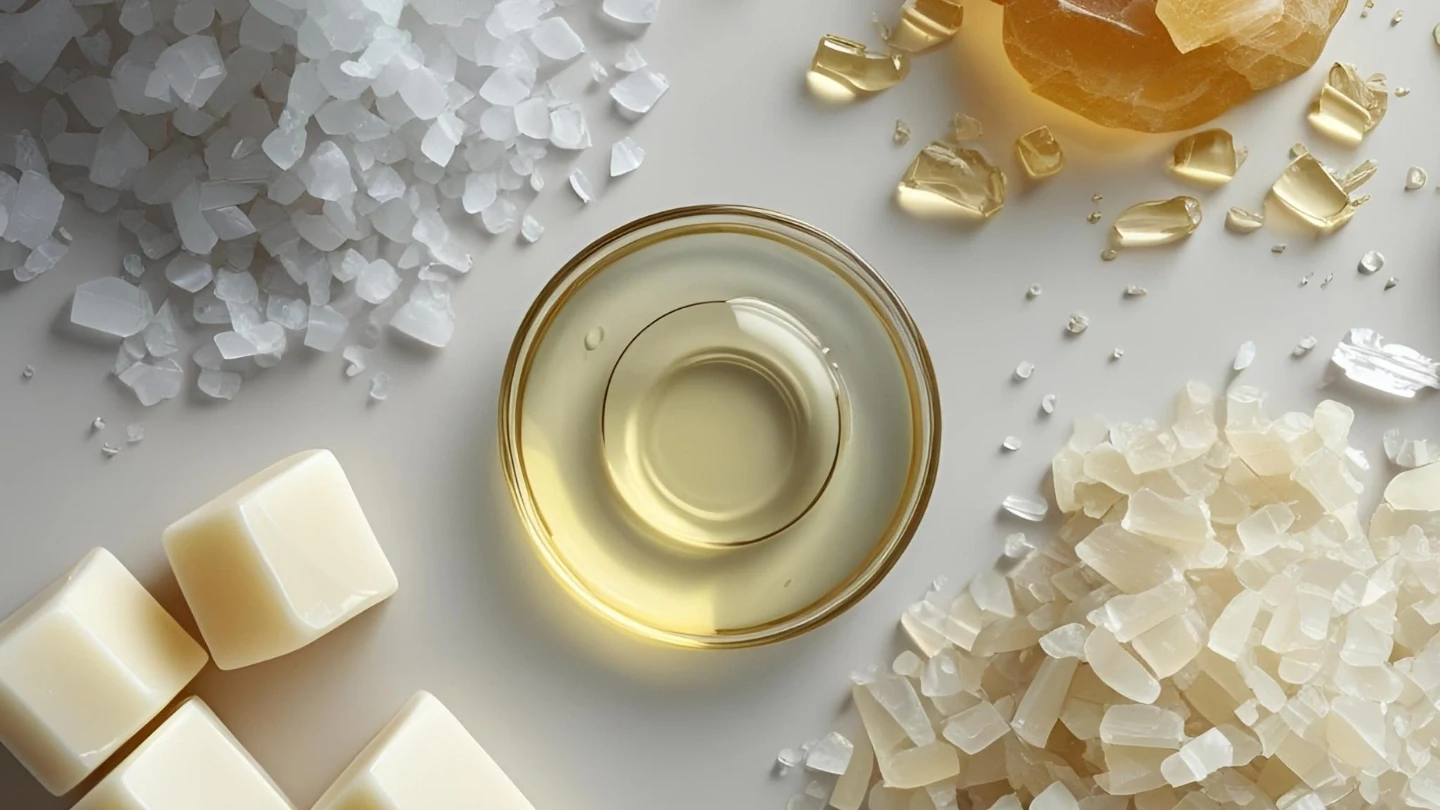Paraffin: Ancient Art and Infinite Variety
**Paraffin** is a versatile substance with a wide range of applications. It refers to a group of saturated hydrocarbons (alkanes) that exist in various forms (solid and liquid) and are derived primarily from petroleum or, in some cases, other sources. This material holds a special place in numerous industries due to its unique properties and infinite variety. This comprehensive guide will explore what **paraffin** is, its rich history, diverse types, production methods, and countless uses.
1. What is Paraffin? Definition and Properties
**Paraffin** is primarily composed of hydrocarbon molecular chains containing carbon and hydrogen atoms. Depending on the length of these chains, **paraffin** can exist as a liquid or a solid:
Paraffin Wax / Solid Paraffin:
- The solid form of **paraffin**, which is white, odorless, tasteless, and waxy at room temperature.
- Its melting point usually ranges from 47 to 64 degrees Celsius.
- It’s composed of longer-chain alkanes (approximately C20 to C40).
- It is hydrophobic (repels water) and insoluble in water.
- It’s a good electrical insulator.
- It is relatively chemically inert.
Liquid Paraffin / Mineral Oil:
- The liquid form of **paraffin**, which is colorless, odorless, tasteless, and transparent.
- It’s composed of shorter-chain alkanes than solid **paraffin** (approximately C15 to C40).
- Available in “industrial” and highly purified “pharmaceutical/food-grade” forms.
2. History and Origin of Paraffin: A Journey Through Time
The discovery and development of **paraffin** marked a significant turning point in various industries, especially in candle-making and the petroleum industry.
Discovery and Naming (Early 19th Century):
- Karl von Reichenbach: A German chemist, formally discovered and identified **paraffin** wax in 1830. He obtained this substance while studying residues from the distillation of wood tar.
- Origin of the name “Paraffin”: Reichenbach chose the name “**paraffin**” from two Latin words: “parum,” meaning “little,” and “affinis,” meaning “affinity” or “inclination” (implying “lack of affinity”). This name was selected due to the substance’s high non-reactivity with other chemicals, which is one of its key properties.
Commercial Development and Early Applications (Second Half of the 19th Century):
- James Young: A Scottish chemist, played a crucial role in the commercialization of **paraffin** production. In the 1850s, he developed processes for extracting **paraffin** (both liquid and solid) from coal and oil shales, producing it commercially. He even became known as “Young’s **Paraffin**” due to his work in this field.
- Revolution in Candle-making: Before **paraffin**’s discovery, candles were primarily made from animal fat (tallow) or beeswax, which produced a lot of smoke and were expensive. **Paraffin** wax revolutionized this industry because:
- Cleaner and More Uniform Burn: **Paraffin** candles produced less smoke and had a more stable flame.
- Lower Production Cost: With the development of petroleum refining methods, **paraffin** production became cheaper than beeswax and animal fat, making candles more accessible to the general public.
- Other Early Uses: In its early days, **paraffin** wax was also used in other industries, including as an insulator for telegraph cables, a waterproofing coating for surfaces, and in match production.
Industrial Growth and Diverse Applications (20th Century Onwards):
- With the growth of the petroleum and meatpacking industries (which produced **paraffin** and stearic acid as by-products), **paraffin** production peaked in the early 20th century.
- Advances in refining processes (like vacuum distillation and hydrocracking) improved the quality of **paraffin**, paving the way for its diverse applications in cosmetics, pharmaceuticals, food, and other industries.
Today, **paraffin** has become one of the most widely used materials globally, maintaining its position due to its desirable properties and cost-effectiveness. For more historical details, you can visit Wikipedia – Paraffin Wax.
3. Main Types of Paraffin: Beyond the Basics
Besides the two main forms (solid and liquid), there are other significant types of paraffin or related materials, each with distinct characteristics and applications:
- Paraffin Wax: The solid **paraffin** described above.
- Liquid Paraffin / Mineral Oil: The liquid **paraffin** described above.
- Microcrystalline Wax:
- A type of petroleum derivative similar to **paraffin** wax, but with a smaller and more irregular crystal structure.
- It has a higher melting point (around 60 to 93 degrees Celsius) and greater flexibility.
- Often used in combination with **paraffin** wax to increase hardness and melting point.
- Chlorinated Paraffin:
- Liquid or solid **paraffin** combined with chlorine.
- Used to increase flame resistance (flame retardant) and as a plasticizer in specific industries.
- Petroleum Jelly / Vaseline:
- A mixture of liquid **paraffin** and microcrystalline wax with some heavier hydrocarbons.
- It’s a semi-solid gel primarily used in health and beauty products.
4. Paraffin Production Method: How Paraffin is Made
Most commercial **paraffin** is derived from crude oil:
- Crude Oil Distillation: Crude oil is heated in refineries and separated into different petroleum fractions based on their boiling points.
- Wax Extraction: Heavier petroleum fractions containing paraffinic hydrocarbons (usually from the “lubricating oil” section) are separated.
- Dewaxing: In this step, oil is separated from the wax. This can be done by cooling the mixture to crystallize the wax, followed by filtration, or by using specific solvents.
- Refining: The crude wax obtained may contain impurities, color, and odor. To produce purer grades (especially food-grade or pharmaceutical-grade), refining processes such as hydrogenation (reaction with hydrogen), treatment with activated clay, or activated carbon are used to remove unwanted compounds.
- Other Methods: **Paraffin** can also be produced synthetically from natural gas (Fischer-Tropsch process) or from coal and oil shale, but production from crude oil remains the most common and economical method.
5. Uses of Paraffin: Household and Industrial Applications
Due to its chemical and physical properties, **paraffin** is used in a wide range of products and processes:
a) Uses of Paraffin Wax (Solid):
- Candle Making: The most common use of **paraffin** wax, due to its suitable melting point, clean burn, and ability to hold fragrance and color.
- Crayons: As a primary component in crayon manufacturing.
- Food Packaging Industry:
- Coating some cheeses to prevent drying and undesirable mold growth.
- Coating fruits (like apples and citrus) to extend shelf life and enhance shine (must be food-grade).
- Added to paper and cardboard to create water-resistant properties in food packaging.
- Cosmetics and Personal Care Industry:
- As a base in lotions, creams, ointments, and lip balms, due to its emollient properties and ability to form a protective barrier on the skin.
- Pharmaceutical Industry:
- As a base in ointments and certain pharmaceutical formulations.
- Waterproofing:
- Coating wood, fabrics (like tents and tarpaulins), and matches for waterproofing.
- Polishes:
- As a key ingredient in shoe polish, furniture polish, and car polish for shine and protection.
- Heat Therapy:
- In physical therapy (**paraffin** therapy) for relieving joint and muscle pain and improving blood circulation.
- Lubricants:
- As a lubricant in some machinery and the textile industry.
- Molding and Sculpting:
- Due to its ease of melting and reshaping.
b) Uses of Liquid Paraffin (Mineral Oil):
- Cosmetics and Personal Care Industry (Pharmaceutical/Cosmetic Grade):
- Baby oil, massage oil, lotions, moisturizing creams, makeup removers.
- As a skin softener and moisturizer.
- Pharmaceutical Industry (Pharmaceutical Grade):
- As a laxative for constipation relief.
- As a lubricant in certain medical procedures.
- Food Industry (Food Grade):
- Lubricant for machinery in food processing where incidental contact with food is permitted.
- Anti-foaming agent in some production processes.
- Oil Lamps: As fuel in decorative lamps and lanterns.
- Industrial Lubricant: In certain industrial machinery requiring a clear, odorless lubricant.
- Oil Baths in Laboratories: To maintain a constant temperature in chemical reactions.
c) Uses of Chlorinated Paraffin:
- Flame Retardant: In plastics, paints, adhesives, and textiles to reduce flammability.
- Plasticizer: In PVC and other polymers to increase flexibility.
- Extreme Pressure Lubricant: In metalworking fluids due to its thermal stability and lubricating properties.
6. Safety and Environmental Considerations for Paraffin
- Flammability: **Paraffin** (especially liquid) is flammable and should be stored in appropriate environments. Vapors from hot **paraffin** can also ignite.
- Quality (Grade): For food, pharmaceutical, or cosmetic uses, it’s essential to use high-grade **paraffin** (known as White Mineral Oil or Food-Grade **Paraffin**) that is free from harmful impurities. Industrial grades may contain carcinogenic or irritating compounds.
- Environment: Paraffins are petroleum derivatives and are not naturally biodegradable. Improper disposal can harm the environment. The industry is exploring more biodegradable alternatives or biomass-based paraffins. You can learn more about environmental impacts of petroleum products on Wikipedia – Petroleum’s Environmental Impact.
- Health:
- Inhalation: Prolonged inhalation of hot **paraffin** vapors can harm the lungs.
- Ingestion: Ingesting large amounts of non-pharmaceutical liquid **paraffin** can be harmful. Pharmaceutical-grade liquid **paraffin** (laxative) should be used as directed by a doctor.
- Skin: **Paraffin** wax in cosmetic products is generally considered safe, but in some sensitive individuals, it can cause clogged pores.
**Paraffin**, due to its desirable chemical and physical properties and relatively low production cost from petroleum derivatives, remains a vital and widely used material in everyday life and various industries. Its infinite variety ensures its continued relevance in a myriad of applications. For further information on this versatile substance, consider visiting a comprehensive chemistry resource or an industry association website.




